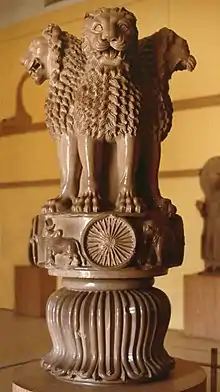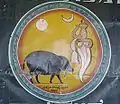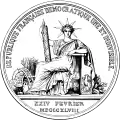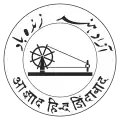State Emblem of India
The State Emblem of India is the national emblem of the Republic of India and is used by the union government, many state governments, and other government agencies. The emblem is an adaptation of the Lion Capital of Ashoka, an ancient sculpture dating back to 280 BCE during the Maurya Empire. The statue is a three dimensional emblem showing four lions. It became the emblem of the Dominion of India in December 1947,[1] and later the emblem of the Republic of India.
| State Emblem of India | |
|---|---|
 | |
| Armiger | |
| Adopted | 26 January 1950 |
| Blazon | Lion Capital of Ashoka |
| Motto | सत्यमेव जयते (Satyameva Jayate): "Truth Alone Triumphs", from the "Mundaka Upanishad", a part of Upanishads |
History
Following the end of British rule on 15 August 1947, the newly independent Dominion of India adopted an official state emblem on 30 December 1947. The emblem consisted of a representation of the Lion Capital of Ashoka at Sarnath enclosed within a rectangular frame.[2][3] Bose set out to complete this task with the help of his students, one of whom was Dinanath Bhargava, then 21 years old.[4] Bose was keen to include the Lion Capital of Ashoka into the opening pages of the constitution. Wanting the lions to be depicted realistically, he chose Bhargava who studied the behaviour of the lions at the Kolkata Zoo.[5]
On 26 January 1950, a representation of the Lion Capital of Ashoka placed above the motto, Satyameva Jayate, was adopted as the State Emblem of India.[6]
Usage and description

The emblem forms a part of the official letterhead of the Government of India and appears on all Indian currency as well. It also functions as the national emblem of India in many places and appears prominently on Indian passports. Usage of the emblem is regulated and restricted under State Emblem of India (Prohibition of Improper Use) Act, 2005, under which no individual or private organisation is permitted to use the emblem for official correspondence. The Ashoka Chakra (Ashoka wheel) on its base features in the centre of the National Flag of India.
The actual Sarnath capital features four Asiatic lions standing back to back, symbolising power, courage, confidence and pride, mounted on a circular base. At the bottom is a horse and a bull, and at its centre is a Dharma chakra. The abacus is girded with a frieze of sculptures in high relief of The Lion of the North, The Horse of the West, The Bull of the South and The Elephant of the East, separated by intervening wheels, over a lotus in full bloom, exemplifying the fountainhead of life and creative inspiration. Carved from a single block of sandstone, the polished capital is crowned by the Wheel of Dharma.
In the emblem finally adopted, only three lions are visible, the fourth being hidden from view. The wheel appears in relief in the centre of the abacus, with a bull on the right and a galloping horse on the left, and outlines of Dharma Chakras on the extreme right and left. A horse and a bull are represented right below the abacus. The bull represents hard work and steadfastness, while the horse represents loyalty, speed, and energy. The bell-shaped lotus beneath the abacus has been omitted.[7]
Forming an integral part of the emblem is the motto inscribed below the abacus in Devanagari script: Satyameva Jayate (Sanskrit: सत्यमेव जयते; lit. "Truth alone triumphs").[8] This is a quote from the Mundaka Upanishad,[9] the concluding part of the sacred Hindu Vedas.
Emblems of national bodies
 Emblem of the Supreme Court of India
Emblem of the Supreme Court of India Emblem of the Central Bureau of Investigation
Emblem of the Central Bureau of Investigation
Emblems of states and union territories
Most of the states and union territories of India have adopted their own state emblem, seal or coat of arms which are used as an official governmental symbol, while six states and five union territories use the National Emblem of India with a text legend as their official governmental seal.
Some of the autonomous district councils established by the Sixth Schedule of the Constitution of India have also adopted an official emblem.
Historic seals and emblems
Pandya Dynasty
 Medieval royal insignia of the Pandya dynasty
Medieval royal insignia of the Pandya dynasty
Vijayanagara Empire
 Emblem of the Vijayanagara Empire
Emblem of the Vijayanagara Empire
Ahom Kingdom
 Insignia of the Ahom kingdom
Insignia of the Ahom kingdom
Mughal Empire
 Seal of the Mughal Empire
Seal of the Mughal Empire
Maratha Empire
 Seal of Shivaji Bhonsle I, 1st Chhatrapati of the Maratha Empire
Seal of Shivaji Bhonsle I, 1st Chhatrapati of the Maratha Empire Closing Seal of Shivaji Bhonsle I
Closing Seal of Shivaji Bhonsle I Royal Seal (left) and Endscript seal (right) of Pratap Singh Bhosale, 8th and last Chhatrapati of the Maratha Empire
Royal Seal (left) and Endscript seal (right) of Pratap Singh Bhosale, 8th and last Chhatrapati of the Maratha Empire
British rule in India
 Coat of arms of the East India Company, used during the Company Raj (1757–1858)
Coat of arms of the East India Company, used during the Company Raj (1757–1858).svg.png.webp) Coat of arms of the United Kingdom, used for official documents, publications and correspondence from the Parliament of the United Kingdom during the British Raj (1858–1947)
Coat of arms of the United Kingdom, used for official documents, publications and correspondence from the Parliament of the United Kingdom during the British Raj (1858–1947) Star of India, an emblem used within India during the British Raj.
Star of India, an emblem used within India during the British Raj.
Portuguese India
.svg.png.webp) Coat of arms of Portuguese India (1600–1935)
Coat of arms of Portuguese India (1600–1935).svg.png.webp) Lesser coat of arms of Portuguese India (1935–1961)
Lesser coat of arms of Portuguese India (1935–1961).svg.png.webp) Greater coat of arms of Portuguese India (1935–1951)
Greater coat of arms of Portuguese India (1935–1951).svg.png.webp) Greater coat of arms of Portuguese India (1951–1961)
Greater coat of arms of Portuguese India (1951–1961)
French India
 Emblem of France used in French India (1912–1954)
Emblem of France used in French India (1912–1954) Great Seal of France
Great Seal of France
Azad Hind
 Seal of Azad Hind (1943–1945)
Seal of Azad Hind (1943–1945)
Dominion of India
.svg.png.webp) Coat of arms of the United Kingdom used by the Dominion of India (15 August – 29 December 1947)[10]
Coat of arms of the United Kingdom used by the Dominion of India (15 August – 29 December 1947)[10].svg.png.webp) Emblem used by the Dominion of India (30 December 1947 – 25 January 1950)[1]
Emblem used by the Dominion of India (30 December 1947 – 25 January 1950)[1] Emblem of the Constituent Assembly of India
Emblem of the Constituent Assembly of India
See also
- Flag of India
- Jana Gana Mana
- Vande Mataram
- National symbols of India
- List of Indian state emblems
- List of Indian state symbols
References
- "Press Communique' - State Emblem" (PDF). Press Information Bureau of India - Archive. Archived (PDF) from the original on 8 August 2017.
- "Celebrating Nandalal Bose, artist who rejected everything British & designed India's constitution". The Print. 3 December 2018.
- Pathak, Yamini (31 March 2016). "Bringing out the kala". The Hindu. ISSN 0971-751X. Retrieved 4 September 2019.
- "We Know Very Little About The Man Who Designed Our National Emblem. Here Are Some Facts Him". The Times of India. 26 December 2016. Retrieved 4 September 2019.
- "A Tribute to the Artist who Sketched and Illuminated India's National Emblem". The Better India. 26 December 2016. Retrieved 4 September 2019.
- "A Tribute to the Artist who Sketched and Illuminated India's National Emblem". The Better India. 26 December 2016. Retrieved 15 September 2019.
- "The State Emblem Of India (Prohibition Of Improper Use) Act, 2005" (PDF). 20 December 2005. p. 4. Archived from the original (PDF) on 19 March 2013. Retrieved 15 April 2012.
- Kamal Dey v. Union of India and State of West Bengal (Calcutta High Court 14 July 2011).Text
- "Rajya Sabha Parliamentary Standing Committee On Home Affairs: 116th Report on The State Emblem Of India (Prohibition Of Improper Use) Bill, 2004" (PDF). Archived from the original (PDF) on 8 March 2013.
- https://upload.wikimedia.org/wikipedia/commons/c/c1/Kashmir_Accession_document_side_2.jpg
